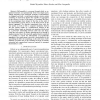65 search results - page 9 / 13 » System Level Simulation of Autonomic SoCs with TAPES |
JVCA
2002
13 years 7 months ago
2002
Behavioural models offer the ability to simulate autonomous agents like organisms and living beings. Psychological studies have showed that the human behaviour can be described by...
PRICAI
2000
Springer
13 years 11 months ago
2000
Springer
Adjustable Autonomy (AA) is the name given to a variety of approaches to the task of giving outside entities the ability to change the level of autonomy of agents in an autonomous ...
CDC
2010
IEEE
13 years 2 months ago
2010
IEEE
This paper deals with hierarchical model predictive control (MPC) of distributed systems. A threelevel hierarchical approach is proposed, consisting of a high level MPC controller,...
COMCOM
2004
13 years 7 months ago
2004
Allocating resources in networks to QoS flows may require undesirable delays or costs. We consider a dynamic Service Level Agreement (SLA) negotiation scheme between peer autonomo...
ICRA
2008
IEEE
14 years 1 months ago
2008
IEEE
Abstract— Self-assembly is a process through which an organized structure can spontaneously form from simple parts. Taking inspiration from biological examples of self-assembly, ...

